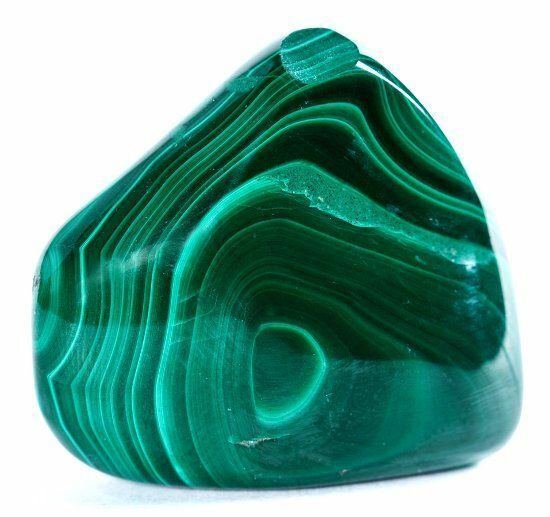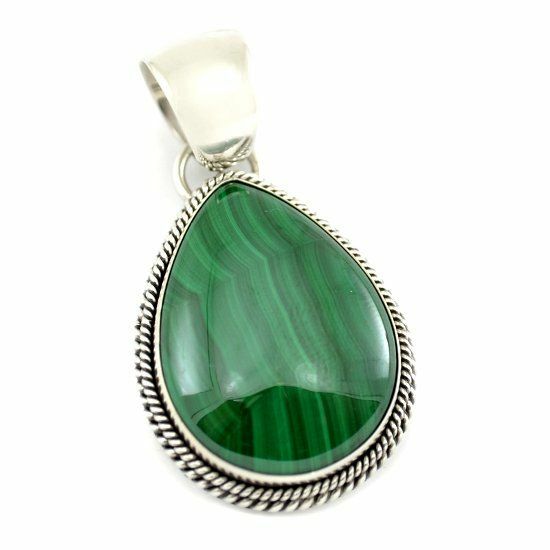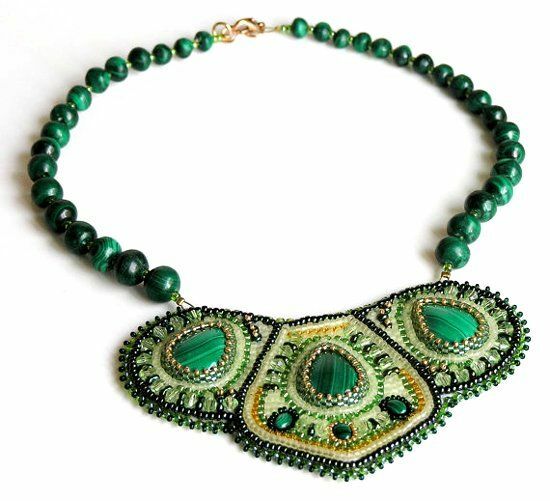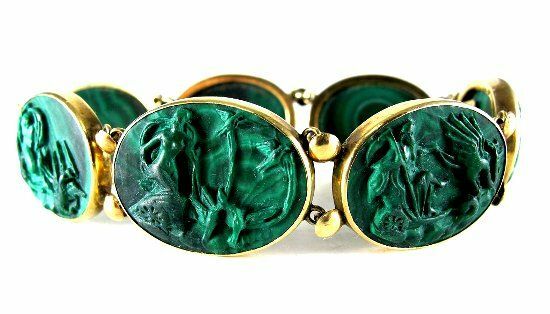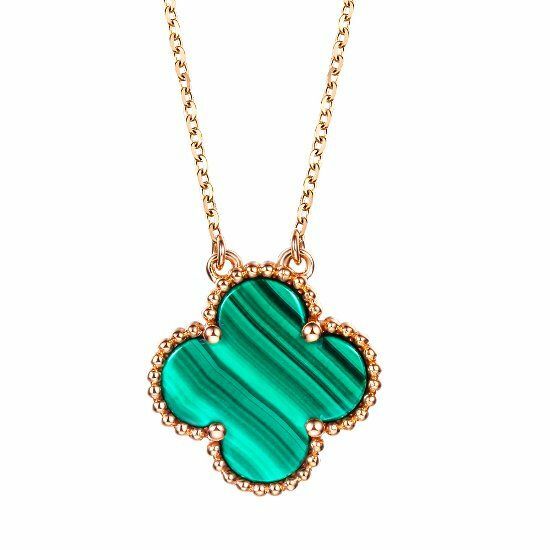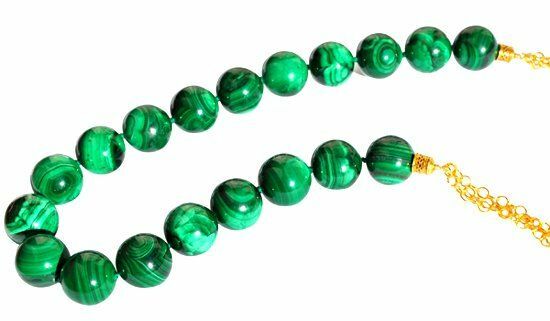
Malachite - a unique patterned jewelry and ornamental stone of a rich green color. This is one of the most beautiful minerals, which is popular in Russia due to the famous Ural writer Pavel Bazhov and his tale "The Malachite Box".
History of the stone
It was the first time to mine malachite 6 thousand years ago in Ancient Egypt. Here he made jewelry in the form of beads and stones, and also made amulets and decorative items, including small figurines of "gemma", bowls for rulers.
Egyptian women used malachite powder for cosmetic purposes, visually lengthening their eyes, Egyptian priests considered this green stone a symbol of the fulfillment of desires, and the pharaohs wore mascots from malachite to make the right decisions.
Malachite was used as an ornamental stone in both Ancient Greece and Rome. In ancient times, palaces and temples were decorated with malachite in these countries. Thus, the columns of the temple of the Goddess Diana in Ephesus, later transferred to Constantinople in the Cathedral of Hagia Sophia, were faced with malachite.
In the Balkans, crushed malachite was used during funeral rites.
In Russia, malachite has long been considered a precious stone. Its industrial development in the Urals began in the middle of the XVII century, although in private the locals found it earlier. Russian master stone-cutters made from malachite and original jewelry, and various beautiful figurines for decoration. Their malachite products in the XIX century gained world fame.
Malachite was so fond of Russia that it was used for interior decorating of these masterpieces of Russian architecture: the Malachite and St George's Halls of the Winter Palace, the columns of St. Isaac's Cathedral, the Malachite Hall in the Hermitage.
But in the East malachite is not particularly revered. Eastern jewelers considered it too soft. In addition, in the eastern countries malachite was considered the main enemy of the emerald. Ancient Arab legends told that malachite can damage the beloved stone of Muslims. This property clearly did not contribute to the popularity of malachite in Muslim countries.
to contents ^Description of mineral
Malachite refers to the second group of jewelry and ornamental stones of the first order according to V.Ya. KIvlenko. This is one of the most common copper minerals on Earth.
Its popularity as an ornamental stone malachite has won thanks to its unusual texture and magnificent green coloration, which varies from light green to almost black with a green tint.
According to one version, the name of this stone has ancient Greek roots and comes from the word "malakos", which is translated from Greek as "soft" and is associated with the amazing softness of this mineral.
According to another version, the name malachite originated from the Turkish word "malahe", which translates as "mallow" and is associated with an amazing rich coloration of the mineral, which resembles the juicy greens of the flower leaves.
Pliny the Elder in his works called this mineral the word "molohites", eventually turned into the modern name of the stone "malachite"( malachite).It was under this name that the mineral first appeared in the mineralogical literature in 1747, in the description of the Swedish scientist Yu. G.Wallerius.
to contents ^Chemical composition and physical properties of the stone
In its chemical composition, malachite is an aqueous copper carbonate. Copper carbonate( chemical formula: Cu2( CO3)( OH) 2) in its composition occupies up to 57.4%.
Malachite can also contain impurities such as cobalt, zinc and nickel.
Malachite crystals have the appearance of very thin needles growing from a common center and forming small spherulites( mineral aggregates of round shape).
This is an opaque stone, but among its small aggregates one can find translucent and translucent specimens at the edges. Malachite differs pleasant matte, somewhat velvety shine. It's quite a fragile stone. Its Mohs hardness is only 3.5-4 units, and the density is about 3.9 g / cm3.
Malachite is a fairly fragile mineral - it is rapidly destroyed by various acids.
The color of the stone represents all shades of green and can vary depending on the copper content from very light tone to a shade of dark green foliage.
to contents ^Malachite varieties
There are several varieties of malachite:
- Radiant malachite is a malachite of fine-grained structure of dark grassy-green color.
- Belt( turquoise) malachite - malachite is light green with a gentle turquoise hue and a beautiful striped pattern. It is used more often than other varieties of malachite for making jewelry.
- Plish malachite - malachite of a deep dark green color with a soft silky ebb. Because of the faded pattern is a less valuable variety of malachite.
- Concentric-zonal malachite - malachite with an unusual ornate pattern.
- Waste kidney-like malachite - malachite with alternation of dark green and light green layers.
- Azur-malachite is an effective mixture of green malachite and saturated bright blue azurite.
Malachite deposits
The most valuable is the famous Urals malachite, but today its fields are completely developed. Today, malachite deposits remained on the territory of Russia only in the Altai, in the Transbaikal Territory( in Udokan) and in the Northern Urals( in the Turinsky mine), it is mined in small quantities.
The main global supplier of malachite is Africa. The main deposits of stone on this continent are in the so-called "copper belt" - on an area of 500 km, which extends from the Congo to Zambia. However, jewelers note that the beauty of the pattern and the color saturation of the Zaire malachite is much inferior to the Urals.
Malachite deposits have also been found in Australia, Kazakhstan, some US states, Armenia, India, China, Nicaragua, Mexico, Hungary, Romania and Brazil.
to contents ^Therapeutic properties of mineral
According to lithotherapists, malachite has a variety of therapeutic properties. In particular, in folk medicine it is used for:
- to improve vision;
- concentration of attention;
- treatment of pancreatitis;
- cough relief for bronchitis;
- treatment of diseases of the spleen;
- relief of gastric colic.
A special effect is observed by lithotherapists when using malachite as a remedy for skin diseases and various allergic reactions.
Use it and with:
- rheumatism;
- joint pain;
- mental disorders;
- headaches;
- for insomnia.
Magic properties of malachite
Our ancestors believed that malachite is connected with the universe and has great magical power. To our days, many legends have told about the abilities of malachite to make a person invisible, to teach him to understand the language of animals and even to fulfill his desires.
There is an opinion that malachite is able to attract attention to its owner. That is why it is recommended to artists, musicians, politicians and orators as a talisman.
The magic properties of the stone include his ability to maintain and strengthen the spiritual strength of man, to harmonize his inner and surrounding world.
to the table of contents ^Malachite and zodiac signs
Astrologers recommend wearing malachite as a talisman to people born under the signs of Libra and Taurus. These signs of the zodiac malachite will give charm and eloquence.
Malachite is also favorable to people born under the sign of Leo. But the Scorpions, Virgos and Cancers carry the products of malachite astrologers do not recommend.
to table of contents ^Application of gem
Malachite is a valuable jewelry and ornamental stone. It is soft enough and graceful in processing, well polished and polished with cabochon.
The main areas of application of malachite:
- Jewelery. From the cabochon malachite made various jewelry: inserts in rings, earrings, brooches, cufflinks, pendants.
- Interior items manufacturing. Especially popular are vases, caskets, table lamps, ashtrays and small figures from malachite.
- Interior decoration. For facing walls use malachite, processed in the form of plates.
Interesting facts about the stone
- In 1972, a block of malachite weighing about 5 tons was found in the Congo, in a field near Kolwezi.
- In 1836 a block of malachite weighing about 400 tons was discovered in the Urals.
- Synthetic malachite was first obtained in 1984 in the Leningrad State University. It differs from natural only monotonous pattern, and is successfully used as an alternative to natural stone.
- Russian craftsmen invented the "Russian mosaic" - a special way of making products from malachite, which allows to reveal the beauty of a stone as much as possible. The essence of this method of processing the stone is as follows: malachite was cut into thin plates and unfolded in the form of an accordion. Later from such malachite "accordion" the figure was selected and stuck on marble or metal. This way in the XVIII-XIX century, mantelpiece, countertops, columns, pilasters, large floor vases and clocks were faced. Today these products of Russian masters are exhibited in the famous museums of the country.
- The brightest example of the famous "Russian mosaic" is the Malachite Hall of the Hermitage, for the decoration of which 25 poods of malachite were used. Here, more than 200 items from this stone are stored.
- 20 tons of malachite was used for the cladding of eight ten-meter columns of St. Isaac's Cathedral.
How to distinguish natural malachite from forgery
There are several reliable ways to make sure that before you is natural malachite, and not its cheap fake of glass or plastic.
- Chemical exposure. You need any acid or ammonia. Try to drip onto a stone with either one liquid or the other - a chemical reaction will not take long to wait. If natural malachite is before you, in case of exposure to it with acid, it will foam and begin to bubble. In the second case, when interacting with ammonia, the color of the most reactive liquid will change, which will turn blue from the copper contained in the malachite, and the stone, which under the drop of ammonia will turn white. Naturally, neither plastic nor glass will give such a reaction.
- Exposure to a sharp object. Considering that malachite is a rather soft stone, you can literally "take off the shavings" with an ordinary sharp knife. Glass with this effect is only slightly scratched, and on the plastic will remain deep, whitish furrows inside.
- Exposure to high temperature. To make sure that you have purchased natural malachite, you can try to heat it over fire. With a strong heating, the plastic will quickly melt, a black stain of soot remains on the glass, and the natural stone will be heated for a long time and will not change in appearance.
Stone Care
Jewelers advise to protect malachite against strong impacts, acids and strong abrasives, sharp temperature changes and ultrasound.
With the care of products made of this stone, only a soapy solution is allowed - no ultrasonic or steam cleaning.
to the table of contents ^Photos of malachite and products from it
